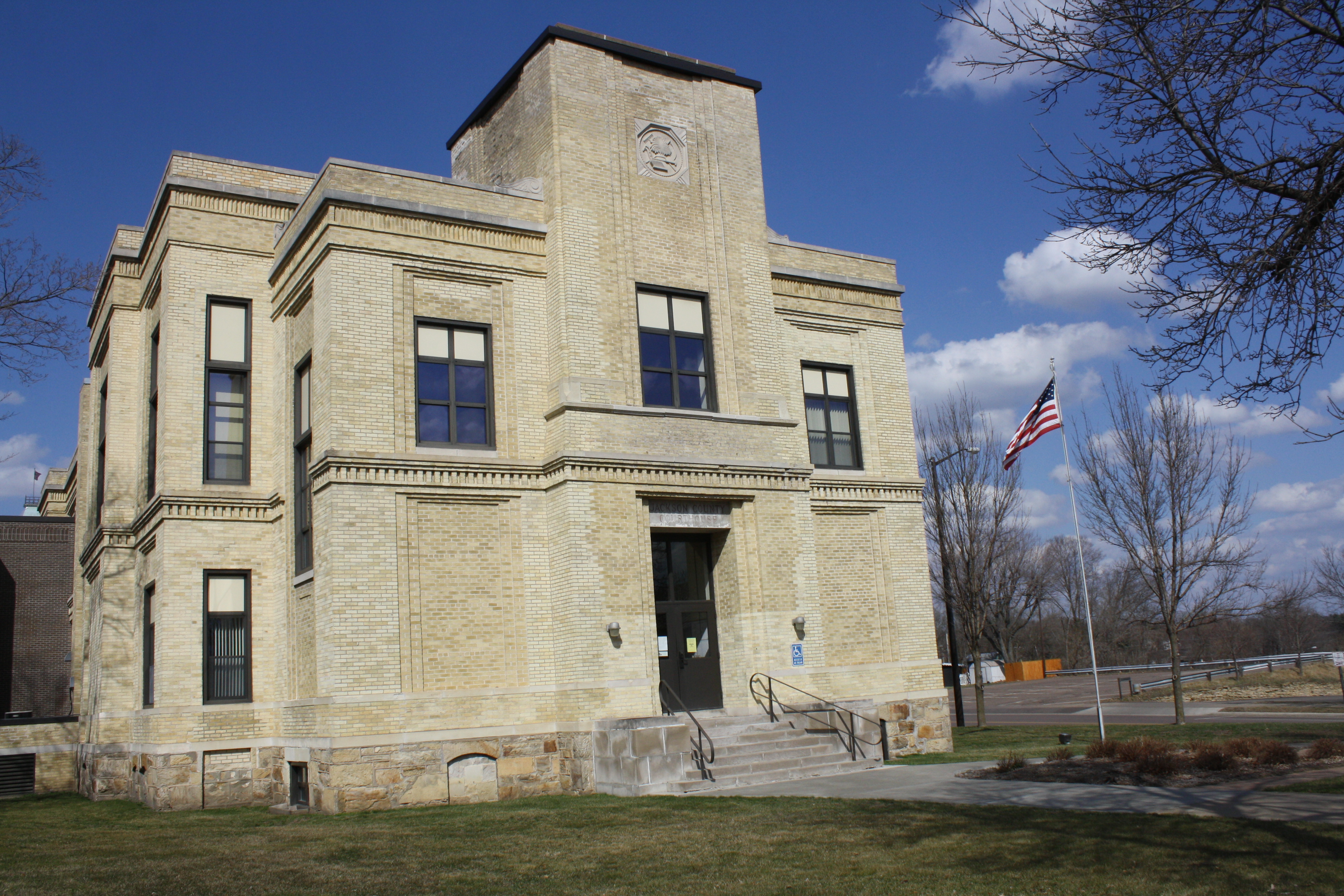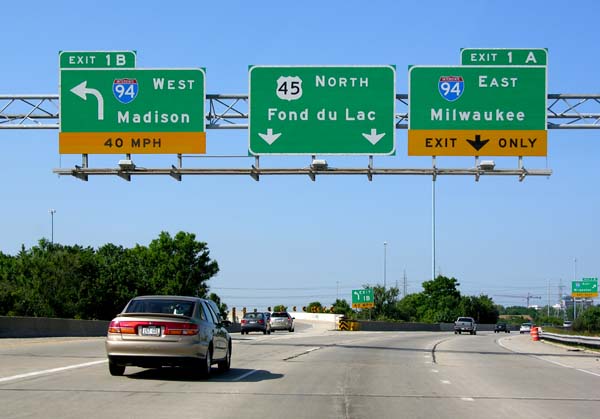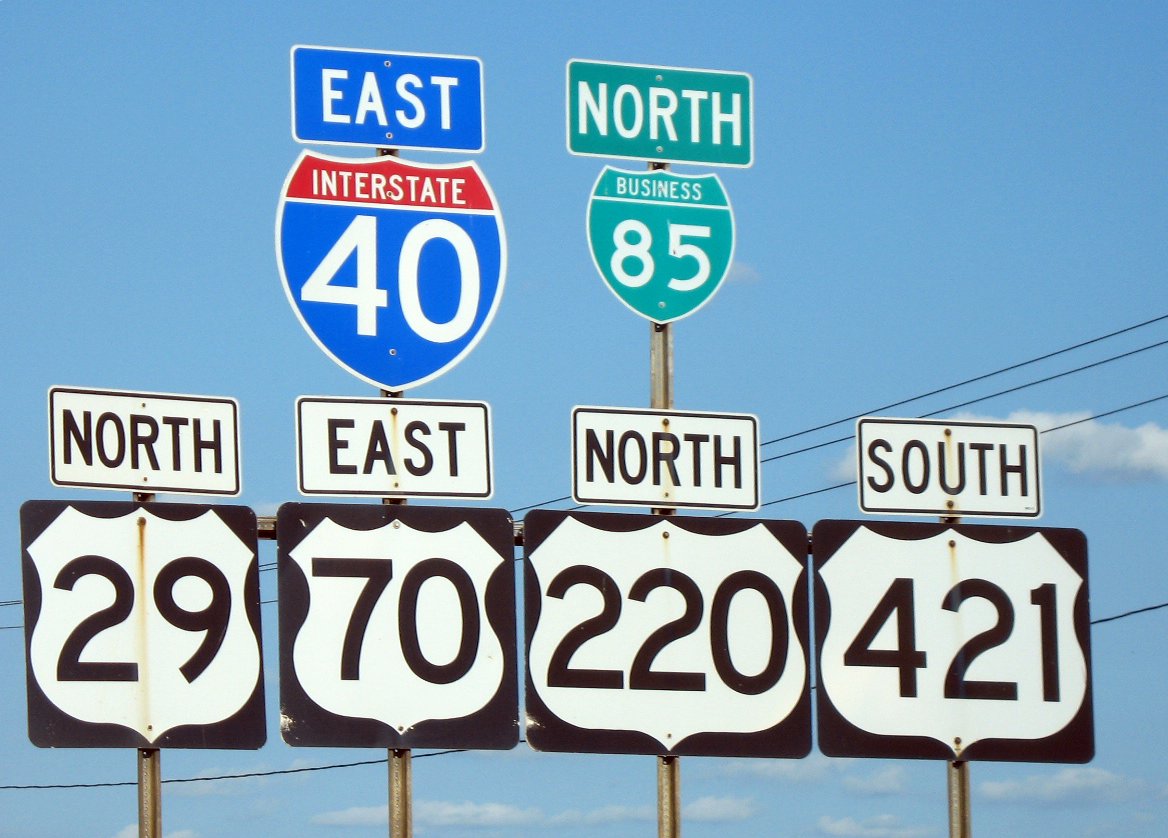|
Wisconsin Highway 12
U.S. Highway 12 (US 12 or Highway 12) in the U.S. state of Wisconsin runs east–west across the western to southeast portions of the state. It enters from Minnesota running concurrently with Interstate 94 (I-94) at Hudson, parallels the Interstate to Wisconsin Dells, and provides local access to cities such as Menomonie, Eau Claire, Black River Falls, Tomah and Mauston. It then provides an alternative route for traffic between northwestern Wisconsin and Madison and is the anchor route for the Beltline Highway around Madison. Finally, it serves southeastern Wisconsin, connecting Madison with Fort Atkinson, Whitewater, Elkhorn and Lake Geneva. The West Beltline Highway and the segment between Elkhorn and Genoa City are freeways, and the segment between Sauk City and Middleton is an expressway. The remainder of the road is a two-lane surface road or an urban multi-lane arterial. Between Hudson and west of Warrens, the road closely parallels the former mai ... [...More Info...] [...Related Items...] OR: [Wikipedia] [Google] [Baidu] |
Hudson, Wisconsin
Hudson is a city in St. Croix County, Wisconsin, United States. As of the 2010 United States census, its population was 12,719. It is part of the Minneapolis–St. Paul Metropolitan Statistical Area (MSA). The village of North Hudson is directly north of Hudson. History Hudson was settled in 1840 by Louis Massey and his brother in-law, Peter Bouchea. William Streets arrived at about the same time. Later that year, Joseph Sauperson (commonly known as Joe LaGrue) took up residence. These four are considered Hudson's original inhabitants. Massey and Bouchea settled at the mouth of the Willow River, near the present-day First and St. Croix Streets. They had been part of a group that lived for some time along the river below Fort Snelling, which appears on some old maps as "Massey's Landing". Hudson was originally called Willow River. It was later named Buena Vista by Judge Joel Foster, founder of River Falls, after returning from the Mexican War where he fought in the Battle o ... [...More Info...] [...Related Items...] OR: [Wikipedia] [Google] [Baidu] |
Sauk County, Wisconsin
Sauk County is a county in Wisconsin. It is named after a large village of the Sauk people. As of the 2020 census, the population was 65,763. Its county seat and largest city is Baraboo. The county was created in 1840 from Wisconsin Territory and organized in 1844. Sauk County comprises the Baraboo, WI Micropolitan Statistical Area and is included in the Madison metropolitan area. History Sauk County was a New England settlement. The original founders of Sauk County consisted entirely of settlers from New England as well as some from upstate New York who had parents who moved to that region from New England shortly after the American Revolution. These people were "Yankee" settlers, that is to say they were descended from the English Puritans who settled New England in the 1600s. While most of them came to Wisconsin directly from New England, there were many who came from upstate New York. These were people whose parents had moved from New England to upstate New York in the imm ... [...More Info...] [...Related Items...] OR: [Wikipedia] [Google] [Baidu] |
Tomah, Wisconsin
Tomah is a city in Monroe County, Wisconsin, United States. The population was 9,570 as of the 2020 census. The city is surrounded by the Town of Tomah and the Town of La Grange. History Tomah was founded by Robert E. Gillett in 1855 and incorporated as a city in 1883, but the charter was not issued until 1894. It is named after Thomas Carron (ca. 1752–1817), a trader at Green Bay who had integrated into the Menominee tribe. The Menominees pronounced the name ''Tomah'' or ''Tomau'' and he became known as Chief Tomah. ''Tomah'' was adopted as the name for the settlement in Monroe County on the unsubstantiated belief that Chief Tomah had once held a tribal gathering in the area. In 1891, construction began in Tomah for a Native American residential school funded by the federal government. The Tomah Indian Industrial School opened in 1893 with six Ho-Chunk children as its first students and would become the most significant residential school in Wisconsin. The curriculum was d ... [...More Info...] [...Related Items...] OR: [Wikipedia] [Google] [Baidu] |
Black River Falls, Wisconsin
, settlement_type = City , nickname = , motto = , image_skyline = Black River Falls Wisconsin Downtown2 WIS54.jpg , imagesize = , image_caption = Looking west at downtown Black River Falls on WIS 54 , image_flag = , image_seal = , image_map = File:Jackson County Wisconsin Incorporated and Unincorporated areas Black River Falls Highlighted.svg , mapsize = 250px , map_caption = Location of Black River Falls in Jackson County, Wisconsin. , image_map1 = , mapsize1 = , map_caption1 = , subdivision_type = Country , subdivision_name = , subdivision_type1 = State , subdivision_name1 = , subdivision_type2 = County , subdivision_name2 = Jackson , government_footnotes = , government_type = , leader_title = , lead ... [...More Info...] [...Related Items...] OR: [Wikipedia] [Google] [Baidu] |
Eau Claire, Wisconsin
Eau Claire (; ) (French for "clear water") is a city mostly located in Eau Claire County, Wisconsin, of which it is the county seat, and with a small portion in Chippewa County, Wisconsin. It had a population of 69,421 in 2020, making it the state's eighth-largest city. Eau Claire is the principal city of the Eau Claire, Wisconsin Metropolitan Statistical Area, locally known as the Chippewa Valley, and is also part of the larger Eau Claire-Menomonie Combined Statistical Area. Eau Claire is at the confluence of the Eau Claire and Chippewa Rivers on traditional Ojibwe, Dakota, and Ho-Chunk land. The area's first permanent European American settlers arrived in 1845, and Eau Claire was incorporated as a city in 1872. The city's early growth came from its extensive logging and timber industries. After Eau Claire's lumber industry declined in the early 20th century, the city's economy diversified to encompass manufacturing and Eau Claire became an educational center with the opening ... [...More Info...] [...Related Items...] OR: [Wikipedia] [Google] [Baidu] |
Menomonie, Wisconsin
Menomonie () is a city in and the county seat of Dunn County in the western part of the U.S. state of Wisconsin. The city's population was 16,843 as of the 2020 census. Named for the original inhabitants of the area, the Menominee, the city forms the core of the United States Census Bureau's Menomonie Micropolitan Statistical Area (MSA), which includes all of Dunn County (2010 population: 43,857). The Menomonie MSA and the Eau Claire–Chippewa Falls metropolitan area to the east form the Census Bureau's Eau Claire-Menomonie Consolidated Metropolitan Statistical Area. The city center is at the south end of Lake Menomin, a reservoir on the Red Cedar River. History The earliest known residents of the area were people from the Trempealeau Hopewell Culture of the Middle Woodland Period (100–400 CE). Evidence from their culture includes a mound from the Wakanda Mounds Group in Wakanda Park, along the western shore of Lake Menomin. Most of these mounds are thought to be from E ... [...More Info...] [...Related Items...] OR: [Wikipedia] [Google] [Baidu] |
Wisconsin Dells, Wisconsin
Wisconsin Dells is a city in Wisconsin, straddling four counties: Adams, Columbia, Juneau, and Sauk. A popular Midwestern tourist destination, the city forms an area known as "The Dells" with the nearby village of Lake Delton. The Dells is home to several water parks and tourist attractions. The city takes its name from the Dells of the Wisconsin River, a scenic, glacial-formed gorge that features sandstone formations along the banks of the Wisconsin River. It is about northwest of Madison, Wisconsin, the state's capital city. Wisconsin Dells has a population of 2,942 people as of the 2020 census. History The natural formation of the Dells was named by Early French explorers as , a rapids or narrows on a river in French. Wisconsin Dells is located on ancestral Ho-Chunk and Menominee land. The Ho-Chunk name for Wisconsin Dells is , meaning "rocks close together". According to Indian agent Joseph Montfort Street, the Sauk leader Black Hawk sought refuge with Ho-Chunks ne ... [...More Info...] [...Related Items...] OR: [Wikipedia] [Google] [Baidu] |
Interstate 94 In Wisconsin
Interstate 94 (I-94) runs east–west through the western, central, and southeastern portions of the US state of Wisconsin. A total of of I-94 lie in the state. Route description The route, cosigned with US Highway 12 (US 12), enters from Minnesota just east of the Twin Cities. The route passes north of Menomonie and south of Eau Claire before turning southeast and heading toward Tomah where it joins I-90. The two Interstates run concurrently for the next to Madison. I-94 enters the state as a six-lane facility which reduces to four-lane at exit 4 (US 12). I-94 passes by the popular tourist destination of Wisconsin Dells. The route converges with I-39 southeast of Tomah (near Portage). This concurrency () is the longest three-route concurrency of the Interstate Highway System and only one of two in existence. The interchanges mark a return to a six-lane configuration. I-94 turns eastward toward Milwaukee at what is commonly known as the " ... [...More Info...] [...Related Items...] OR: [Wikipedia] [Google] [Baidu] |
Concurrency (road)
A concurrency in a road network is an instance of one physical roadway bearing two or more different route numbers. When two roadways share the same right-of-way, it is sometimes called a common section or commons. Other terminology for a concurrency includes overlap, coincidence, duplex (two concurrent routes), triplex (three concurrent routes), multiplex (any number of concurrent routes), dual routing or triple routing. Concurrent numbering can become very common in jurisdictions that allow it. Where multiple routes must pass between a single mountain crossing or over a bridge, or through a major city, it is often economically and practically advantageous for them all to be accommodated on a single physical roadway. In some jurisdictions, however, concurrent numbering is avoided by posting only one route number on highway signs; these routes disappear at the start of the concurrency and reappear when it ends. However, any route that becomes unsigned in the middle of the concurren ... [...More Info...] [...Related Items...] OR: [Wikipedia] [Google] [Baidu] |
Minnesota
Minnesota () is a state in the upper midwestern region of the United States. It is the 12th largest U.S. state in area and the 22nd most populous, with over 5.75 million residents. Minnesota is home to western prairies, now given over to intensive agriculture; deciduous forests in the southeast, now partially cleared, farmed, and settled; and the less populated North Woods, used for mining, forestry, and recreation. Roughly a third of the state is covered in forests, and it is known as the "Land of 10,000 Lakes" for having over 14,000 bodies of fresh water of at least ten acres. More than 60% of Minnesotans live in the Minneapolis–Saint Paul metropolitan area, known as the "Twin Cities", the state's main political, economic, and cultural hub. With a population of about 3.7 million, the Twin Cities is the 16th largest metropolitan area in the U.S. Other minor metropolitan and micropolitan statistical areas in the state include Duluth, Mankato, Moorhead, Rochester, and ... [...More Info...] [...Related Items...] OR: [Wikipedia] [Google] [Baidu] |
Wisconsin
Wisconsin () is a state in the upper Midwestern United States. Wisconsin is the 25th-largest state by total area and the 20th-most populous. It is bordered by Minnesota to the west, Iowa to the southwest, Illinois to the south, Lake Michigan to the east, Michigan to the northeast, and Lake Superior to the north. The bulk of Wisconsin's population live in areas situated along the shores of Lake Michigan. The largest city, Milwaukee, anchors its largest metropolitan area, followed by Green Bay and Kenosha, the third- and fourth-most-populated Wisconsin cities respectively. The state capital, Madison, is currently the second-most-populated and fastest-growing city in the state. Wisconsin is divided into 72 counties and as of the 2020 census had a population of nearly 5.9 million. Wisconsin's geography is diverse, having been greatly impacted by glaciers during the Ice Age with the exception of the Driftless Area. The Northern Highland and Western Upland along wi ... [...More Info...] [...Related Items...] OR: [Wikipedia] [Google] [Baidu] |
Walworth County, Wisconsin
Walworth County is a county located in the U.S. state of Wisconsin. As of the 2020 census, the population was 106,478. Its county seat is Elkhorn. The county was created in 1836 from Wisconsin Territory and organized in 1839. It is named for Reuben H. Walworth. Walworth County comprises the Whitewater-Elkhorn, WI Micropolitan Statistical Area and is included in the Milwaukee-Racine- Waukesha, WI Combined Statistical Area. Lake Geneva, the University of Wisconsin-Whitewater, and Alpine Valley Resort, and Music Theatre are located in Walworth County. Geography According to the U.S. Census Bureau, the county has a total area of , of which is land and (3.7%) is water. Transportation Major highways * Interstate 43 * U.S. Highway 12 * U.S. Highway 14 * Highway 11 (Wisconsin) * Highway 20 (Wisconsin) * Highway 36 (Wisconsin) * Highway 50 (Wisconsin) * Highway 59 (Wisconsin) * Highway 67 (Wisconsin) * Highway 83 (Wisconsin) * Highway 89 (Wisconsin) * Highway 120 ( ... [...More Info...] [...Related Items...] OR: [Wikipedia] [Google] [Baidu] |







